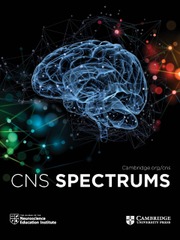Article contents
Central Nervous System Opportunistic Infections in HIV-1 Infection
Published online by Cambridge University Press: 07 November 2014
Abstract
Neurologic disease is commonly encountered in the population infected with human immunodeficiency virus type 1 (HIV-1). Although HIV-1 is responsible for many of these neurologic complications, other organisms will affect the nervous system as the immune deficiency state progresses. With the wide use of potent antiretroviral therapy, the mortality from and incidence of opportunistic infections (OIs) among persons with advanced HIV-1 infection has decreased. Nevertheless, these diseases are still seen frequently, especially among those with limited access to new antiretroviral therapies. Therefore, it remains important to recognize the most common OIs of the central nervous system (CNS) as well as primary CNS lymphoma, which will be the focus of this review.
- Type
- Feature Articles
- Information
- CNS Spectrums , Volume 5 , Issue 4: HIV and the Central Nervous System: Part One , April 2000 , pp. 43 - 60
- Copyright
- Copyright © Cambridge University Press 2000
References
REFERENCES
- 8
- Cited by


